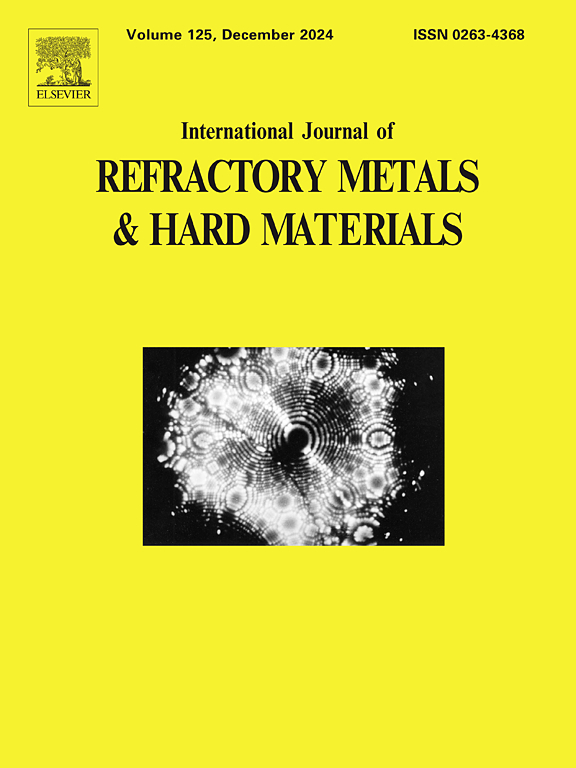Investigation of the influence and mechanism of annealing temperature on the crushing strength of W layer prepared by chemical vapor deposition for nuclear thermal propulsion: Experimental and modeling analysis
IF 4.2
2区 材料科学
Q2 MATERIALS SCIENCE, MULTIDISCIPLINARY
International Journal of Refractory Metals & Hard Materials
Pub Date : 2025-05-12
DOI:10.1016/j.ijrmhm.2025.107229
引用次数: 0
Abstract
The design of tungsten (W)-coated fuel particles represents one of the pivotal strategies for enhancing the performance of cermet fuel. An intact W coating not only facilitates effective containment of fission products, enabling uniform dispersion of the fuel, but also effectively hinders the inward diffusion of the operating medium (H2), thereby reducing fuel loss. However, during the preparation of cermet fuel, external pressure is often employed simultaneously to achieve high densification of the fuel pellets. In such scenarios, high external pressure may lead to damage to the W coating, rendering it ineffective in fulfilling its designed functions. Given this situation, the present study investigates the compressive performance of W layer annealed at different temperatures by experiments and simulations. The experimental results indicate that as the annealing temperature increases from 900 °C to 2300 °C, the maximum loading force value on the coated particles gradually decreases, ranging from 381.58 N to 135.99 N. Concurrently, the average grain size grows from an initial 0.36 μm at 900 °C to 13.30 μm at 2300 °C. Finite element simulations reveals that the fracture of W-coated particles initiates within the W layer itself, indicating that the crushing strength of the coated particles is equivalent to the crushing strength of the W layer. As the annealing temperature rises, the crushing strength of the W layer initially exhibits an increase, from 869.96 MPa at 900 °C to 874.59 MPa at 1500 °C. Subsequently, it declines to 750.10 MPa at 2300 °C. This trend can be attributed to the combined influences of surface densification and W grain size. Furthermore, a comprehensive discussion on how grain size, influenced by annealing temperature, affects the crushing strength of the W layer is also conducted by the analysis of stress distribution. This study explores, for the first time, the variation in crushing strength of W coatings with annealing temperature, thereby offering robust support for the optimized preparation of cermet fuels used in NTP systems.
退火温度对核热推进用化学气相沉积W层抗压强度的影响及机理研究:实验与模型分析
钨包覆燃料颗粒的设计是提高金属陶瓷燃料性能的关键策略之一。完整的W涂层不仅有助于有效遏制裂变产物,使燃料均匀分散,而且还有效地阻止操作介质(H2)向内扩散,从而减少燃料损失。然而,在制备金属陶瓷燃料的过程中,为了实现燃料球团的高密度化,往往同时采用外部压力。在这种情况下,高的外部压力可能会导致W涂层的损坏,使其无法实现其设计功能。在这种情况下,本研究通过实验和模拟研究了不同温度下W层的压缩性能。实验结果表明:随着退火温度从900℃升高到2300℃,涂层颗粒的最大加载力逐渐减小,从381.58 N减小到135.99 N,平均晶粒尺寸从900℃时的0.36 μm增大到2300℃时的13.30 μm;有限元模拟结果表明,W包覆颗粒的断裂始于W层内部,表明包覆颗粒的抗压强度与W层的抗压强度相当。随着退火温度的升高,W层的抗压强度从900℃时的869.96 MPa增加到1500℃时的874.59 MPa。随后,它在2300℃时下降到750.10 MPa。这种趋势可归因于表面致密化和W晶粒尺寸的综合影响。此外,通过对应力分布的分析,全面探讨了晶粒尺寸随退火温度的变化对W层抗压强度的影响。本研究首次探索了W涂层抗压强度随退火温度的变化,从而为NTP系统中使用的金属陶瓷燃料的优化制备提供了强有力的支持。
本文章由计算机程序翻译,如有差异,请以英文原文为准。
求助全文
约1分钟内获得全文
求助全文
来源期刊
CiteScore
7.00
自引率
13.90%
发文量
236
审稿时长
35 days
期刊介绍:
The International Journal of Refractory Metals and Hard Materials (IJRMHM) publishes original research articles concerned with all aspects of refractory metals and hard materials. Refractory metals are defined as metals with melting points higher than 1800 °C. These are tungsten, molybdenum, chromium, tantalum, niobium, hafnium, and rhenium, as well as many compounds and alloys based thereupon. Hard materials that are included in the scope of this journal are defined as materials with hardness values higher than 1000 kg/mm2, primarily intended for applications as manufacturing tools or wear resistant components in mechanical systems. Thus they encompass carbides, nitrides and borides of metals, and related compounds. A special focus of this journal is put on the family of hardmetals, which is also known as cemented tungsten carbide, and cermets which are based on titanium carbide and carbonitrides with or without a metal binder. Ceramics and superhard materials including diamond and cubic boron nitride may also be accepted provided the subject material is presented as hard materials as defined above.

 求助内容:
求助内容: 应助结果提醒方式:
应助结果提醒方式:


